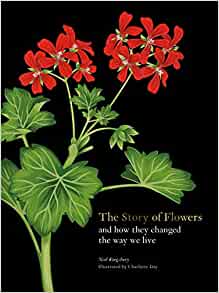Noel Kingsbury, The Story of Flowers and How They Changed the Way we Live. Laurence King 2022. Illustrations by Charlotte Day.

Our thanks to Craig Swick for this book review.
This book is about one hundred flowering plants introduced into gardens since ancient times. Each plant has a two-page entry that describes its history in the garden and some important medical or cultural facts. The second page is a watercolor illustration that shows the blossom, some leaves, and a detail of some other part such as the seeds or seed pods. The illustrations are not completely botanically accurate but are pleasant to look at and are a good representation of what is important to know about the plant.
The book is organized in a curious way. The plants are presented in historical groups of when they were first described by botanical writers (ancient, medieval, 18th century, 19th century, and 20th century) and then alphabetized by the Latin name for the plant. I found this historical arrangement confusing because a plant not known in Europe until recently may have been popular with Chinese writers for many centuries.
Most of the plants in the book are European but a good number are from Asia. The type of information presented varies from flower to flower. Some contain more about the historical uses, others more about the breeding that led to commercial varieties, and others more about interesting cultural or folklore beliefs.
Two examples of entries I really liked were snowdrops and poinsettias. Snowdrops are in the Late Medieval section because they did not reach northern Europe until the sixteenth century. The author notes they were well established by Victorian times. The snowdrop came to be associated with chastity and was used by churches to try to influence the behaviour of the working-class girls who had come from the farms and villages to work in the mills and factories. There were Snowdrop clubs, similar to temperance societies. There was also a magazine of moral tales called The Snowdrop.
The poinsettia is in the 19th century section because even though it was known in pre-Columbian cultures it was not introduced to Western gardening until the early 1800s. The author talks about Joel Roberts Poinsett bringing the plant to the United States and about the work the Ecke family did in developing it into a commercial success. The story I like is of the poor girl who could not afford to take beautiful flowers to church and so took the roadside weeds she could pick. When she put them on the altar they turned into a poinsettia.
It is best to read this book a couple of flowers at one time. There are many interesting bits of history or folklore and the drawings are enjoyable. It is not a good reference book, however, because the number of plants are limited and there is only one page of information about each plant. I would recommend it as a gift book or coffee table book or for people who have a large plant library and would like to add the tales from the book.
Craig Swick, April 2023
